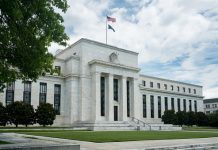Markets
The Fed debate will rage on after a colossus NFP headline followed by Chair Powell speech which then went well beyond the market expectations by yawing dovish the Feds monetary policy reaction function.
Fed Chair Powell’s dovish confirmation was music to equity investors ears while EM and high beta currencies celebrated in the afterglow in a flip-flop Friday for the greenback. The USD initially gained after the behemoth NFP print only to shed those gains post- Fed Chair Powell who signalled the ” all green” for risk while suggesting he ” wouldn’t hesitate ” to tweak balance sheet reductions if it was tightening financial conditions beyond need. After all, what investor doesn’t like a strong economy and a dovish lean from the Fed all the while the NFP report should put to rest fears sky is not falling on the US economy and could reinforce the notion that recent turmoil, particularly on the S&P 500, as a ‘market correction’ instead of an economic problem.
However, the key in Chair Powell’s latest messaging is that he addressed concerns that the global equity market turmoil is a clear and present threat to US economic growth
Equity markets usually struggle as cash becomes tighter during a Fed rate hike cycle triggering investors to reduce risk. But the emotional market meltdown in Q4 which tightened financial conditions so much so that the Fed will likely pause until at least mid-2019 to let the dust settle. However what’s critical is the comparison Powell drew between 2016 and 2019. In both periods markets were hyper-volatile, and speculation was rife about the possibility of a US growth slowdown. Powell suggested that if 2019 were to unfold like 2016, the current FOMC would likely take a similar course of action as after hiking in December 2015, the committee back then paused and did not increase rates again until December 2016. So Indeed, it appears Chair Powell is becoming far more patient with regards to the pace of rate hikes in 2019
However, this upcoming week will probably bring more questions than answers as investors will have ample opportunity to test the markets new found bullish resolve. Traders will be laying the groundwork for the string of top-tier USD events such as Fedspeak, including from San Fran President Daly and VP Clarida; ISM Services; FOMC December minutes; US CPI and the omnipresent trade uncertainly to watch over as US-China trade talks are expected to resume. But with the latest fed skew in place, could we return to the Goldilocks economy or end up with yet another fractured market fairy tale?
Thankfully risk sentiment is on more stable footing than we opened 2019 as a confluence of factors including the PBOC RRR cut, China and the US will hold vice-ministerial-level trade talks this week and of course Chair Powell comments which elevated the chances the Fed will pause interest rate increases until at least mid 2019 are all market-friendly developments. However, some investors remain sceptical that Friday’s price action was little more than a vicious short covering frenzy after their portfolios were beaten to a pulp during the past 90 days. And while the markets have been mired in disappointing global economic data, the softer Fed and robust US payrolls data could go a long way to stabilising investor sentiment.
Oil Markets
The US economy added more jobs than expected in December, prompting a sharp recovery in the S&P 500 that provided a robust framework for supporting oil prices that were already rebounding after early estimates showed OPEC crude oil production falling roughly 0.5 mmbpd during December as Saudi Arabia has chopped production.
And while the EIA weekly inventory report dampened sentiment and reminding traders about the bearish inventory story. At at a minimum, however, the robust NFP, a softer Fed mandate, more Pboc easing likely, a further thaw in US-China trade tensions and a drop in OPEC production suggests a more positive outlook despite the EIA reporting both gasoline and distillate inventories showing significant builds indicating the US supply glut remains a bearish concern.
However, those inventory gluts could be reversed out as Saudi Arabia makes good on its pledge to slash exports to the US by a reported 60 % between November and December and the impact should start to show up in the closely watched US inventory reports
Gold Markets
Gold markets recent gains have been staggering, but with equity markets showing signs of stabilising investors are left wondering if this current gold rally is the real deal or not. Stock markets were making investors very nervous throughout the holiday period, and by the looks of late December Gold price action, it was clear that many investors missed the boat and were not long nearly enough gold hedge vs the equity markets meltdown. But this too suggests there is a lot of freshly minted longs at or near the top of the recent gold run which makes prices extremely susceptible to favourable equity market flows, as we saw on Friday.
In early November equity markets were signalling significant pullbacks as even usually reliable tech stocks, including Netflix, Facebook and Amazon were tanking, but the move to $1300 has been extraordinarily swift. And while demand pales in comparison the to glory days of 2011, it’s gradually broadening, and as we approach typical seasonality demand in January ahead of China Lunar New Year, gold could also be in for a retail revival.
But with impressive rallies on a cross currency basis with XAUAUD trading at an all-time high, one would expect some gold producing countries to view current levels as attractive to hedge future production. The big question is now where current investor demand will outstrip hedging supply at the current level to keep the current market momentum going.
Given the uncertain financial market climate, gold should continue to flourish, and for those that have missed the boat, pullbacks could be an excellent opportunity to engage. But in the unlikely case that stock markets start to draw more affection from investors, gold could struggle over the near term to regain momentum and prices could slip aggressively
Currency Markets
Continue to expect currency markets to be driven by equity market sentiment, but with traders already leaning bearish USD into 2019, Chair Powell’s dovish pivot when taken at face value could see US interest rates remain on hold through 2019, suggesting the US dollar could weaken. Of course, this is very much a data dependent storyline, however, without calendar-based US rate hikes to tether itself, for at least the first part of 2019, the US dollar remains incredibly susceptible to weaker US economic data even more so with US economic surprise index starting the year in negative territory. Mind you this could be more of a factor of the softer December US data and the recent market tumult, but even within this context, a more data dependent Fed, given the current cards on the table does suggest further USD weakness in the weeks ahead.
The Malaysian Ringgit
In the wake of Fed Chair Powell dovish comments on Friday green lighting risk, EM Fx has outperformed globally. A weaker US dollar a lower glide path for US interest rates is always a welcome relief for Aisa currencies. But adding to the MYR appeal is a further thaw in US-China trade tensions, and when coupled with a robust crude oil rally, which looks likely to extend, the Ringgit is trading favourably as global risk sentiment stabilises
The Yuan
Last week’s PBOC liquidity injection via RRR has triggered a positive tone across the region but its early days. However, given the fact this cut will have a negligible impact on the economy and it’s only a means to provide liquidity in January ahead of Lunar New Year( LNY), it won’t have much legs. But what the market is reading into Pboc policy is if the data continues to run south in China ahead of LNY, the central bank could trigger more easing through a TFL or TMF. The central bank policy support should be good enough to stabilize mainland equity markets over the short term and would be Yuan supportive. The low valuations and higher risk premiums in China are a function of expectations for a further drop in economic growth and the constant downdraft from US-China trade negotiations.
The Pboc stimulus could right the economic ship while the thawing in SU -China trade tensions could trigger significant bargain basement buying on the Shanghai Composite.











